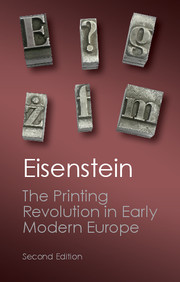Book contents
- Frontmatter
- Contents
- List of Illustrations and Maps
- Preface to the Second Edition
- Introduction
- THE PRINTING REVOLUTION IN EARLY MODERN EUROPE
- PART I THE EMERGENCE OF PRINT CULTURE IN THE WEST
- 1 An Unacknowledged Revolution
- 2 Defining the Initial Shift
- 3 Some Features of Print Culture
- 4 The Expanding Republic of Letters
- PART II INTERACTION WITH OTHER DEVELOPMENTS
- Afterword: Revisiting the Printing Revolution
- Selected Reading
- Index
1 - An Unacknowledged Revolution
from PART I - THE EMERGENCE OF PRINT CULTURE IN THE WEST
Published online by Cambridge University Press: 05 October 2013
- Frontmatter
- Contents
- List of Illustrations and Maps
- Preface to the Second Edition
- Introduction
- THE PRINTING REVOLUTION IN EARLY MODERN EUROPE
- PART I THE EMERGENCE OF PRINT CULTURE IN THE WEST
- 1 An Unacknowledged Revolution
- 2 Defining the Initial Shift
- 3 Some Features of Print Culture
- 4 The Expanding Republic of Letters
- PART II INTERACTION WITH OTHER DEVELOPMENTS
- Afterword: Revisiting the Printing Revolution
- Selected Reading
- Index
Summary
In the late fifteenth century, the reproduction of written materials began to move from the copyist's desk to the printer's workshop. This shift, which revolutionized all forms of learning, was particularly important for historical scholarship. Ever since then historians have been indebted to Gutenberg's invention; print enters their work from start to finish, from consulting card files to reading page proofs. Because historians are usually eager to investigate major changes and this change transformed the conditions of their own craft, one would expect the shift to attract some attention from the profession as a whole. Yet any historiographical survey will show the contrary to be true. It is symbolic that Clio has retained her handwritten scroll. So little has been made of the move into the new workshops that after five hundred years, the muse of history still remains outside. “History bears witness,” writes a sociologist, “to the cataclysmic effect on society of inventions of new media for the transmission of information among persons. The development of writing, and later the development of printing, are examples.” Insofar as flesh-and-blood historians who turn out articles and books actually bear witness to what happened in the past, the effect on society of the development of printing, far from appearing cataclysmic, is remarkably inconspicuous. Many studies of developments during the last five centuries say nothing about it at all.
There is, to be sure, a large, ever-growing literature on the history of printing and related topics. Several works that synthesize and summarize parts of this large literature have appeared.
- Type
- Chapter
- Information
- The Printing Revolution in Early Modern Europe , pp. 3 - 12Publisher: Cambridge University PressPrint publication year: 2012

